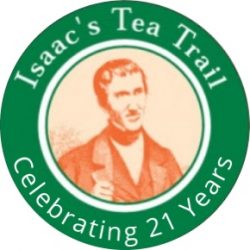
Isaac Holden was born around 1805 in Mohope in the Ninebanks grieveship of the West Allen. The family were known to be amongst the poorest and he never attended a school. The Holden’s were lead miners as most others were or employed in processing or transporting the ore. The market for lead boomed in the 1700s at home and abroad but made the miners vulnerable when the trade slumped in times of recession. Born into this way of life Isaac was indistinguishable from his contemporaries. Yet by the end of his life he had assumed almost a legendary status with the grandest memorial in Allendale churchyard with a revealing dedication.

“ISAAC HOLDEN A native of this parish who died November 12th 1857, aged 51 years. He gained the esteem and respect of the public by his untiring diligence in originating works of charity and public usefulness upwards of 600 persons subscribed to erect this monument.”
The reminders are still there :-
- Wesleyan Chapel (Allendale, 1839)
- Savings Bank (Allendale, 1840s)
- Isaac’s Well (Allendale, 1849)
- Hearse House (Ninebanks,1856)
- Also other charitable ventures such as a Clothing Fund for Women and Children
How he won the respect across the community is the inspiration for Isaac’s Tea Trail and an invitation to follow in his footsteps. Along the way you will discover the hidden heritage of this remote part of Northern England. Even if the history holds no attraction you can simply enjoy some of the best that the North Pennines has to offer.
Isaac and Tea
If Isaac had remained a lead miner, there would probably have been no memorial or trail. What changed everything was a down turn in the lead trade in the early 1830s and the near exhaustion of ore in the mine where he worked. At this time of acute crisis, Isaac changed from lead miner to be an itinerant tea seller and energetic fund raiser. It is a matter of speculation as to the exact circumstances behind his career change. Tea selling was a calling driven only out of dire necessity and only one step from the work house.
Thanks to well wishers with connections, he was given advice and a helping hand with access to the tea supply chain. Fortunately in the year’s ahead, tea drinking grew steadily in popularity. As the price dropped with reductions in import tariffs, so tea became more affordable and within the reach of most households. In Methodist circuits, chapel tea bazaars became the rage at special anniversaries and for raising funds and tea was much in demand.
Around this time Isaac experienced a life changing religious conversion and was later described as “pious”. Whatever the reasons behind his conversion such emotionally charged occasions were a powerful feature in the close and faith driven communities of the North Pennines.
Isaac, dressed in black, became a familiar figure, uphill and down dale selling tea door to door in all weathers to the mining communities, farmsteads and remote hamlets. Over the years, he became known not only in the Allen Valleys but across the North of England from Carlisle to Newcastle.
For livelihood he peddled tea,
And so went round from door to door;
His tea as good as tea could be,
Though more than tea he kept in store.
(J.Ritson)
Isaac’s Hearse House
The hearse house is a feature of the trail. The small sandstone building goes back to 1856 when it was built to keep the Holden Hearse purchased from the proceeds of Isaac’s last great fund-raising venture. Ever since it has stood unobtrusively by the roadside about 40 yards along from the old Ninebanks School built a couple of years before
When the hearse was no longer needed from the 1930s the condition of the building steadily deteriorated until 2015, when with the help of the Allen Valley’s Heritage and Landscape Project, it was fully restored. Now it has a new role as a community place with interpretive panels and trail related material, where you can enter your name in the visitors’ book and absorb the atmosphere from the past.




